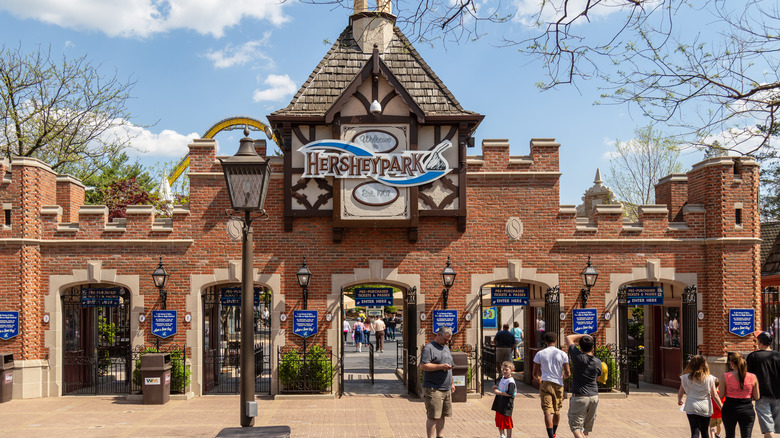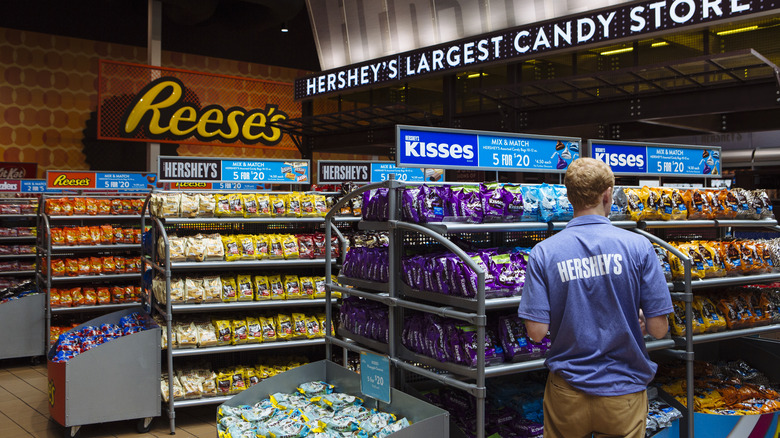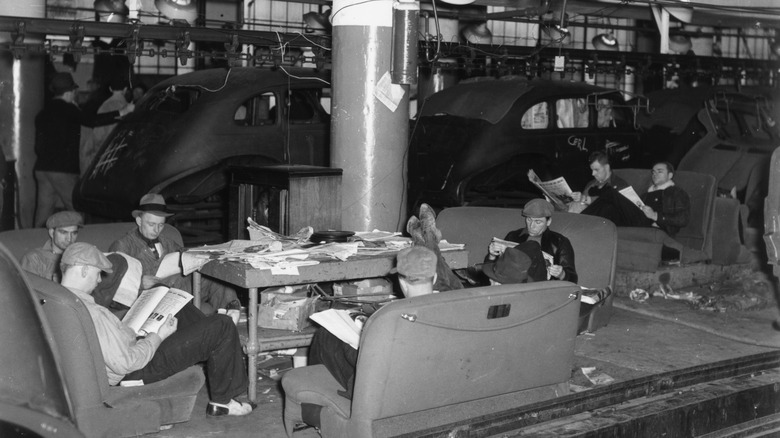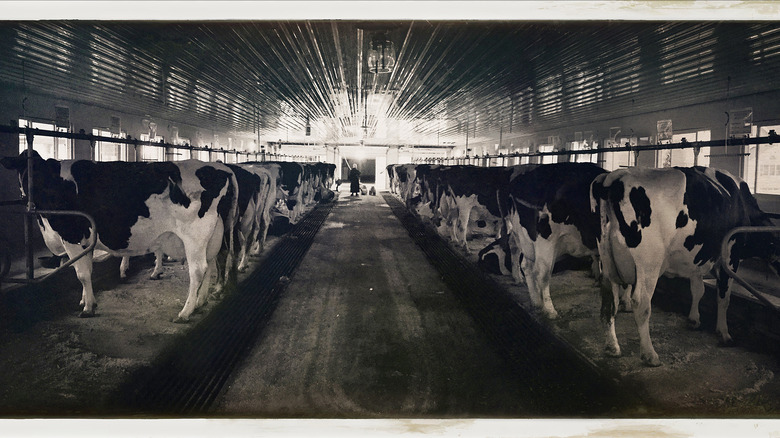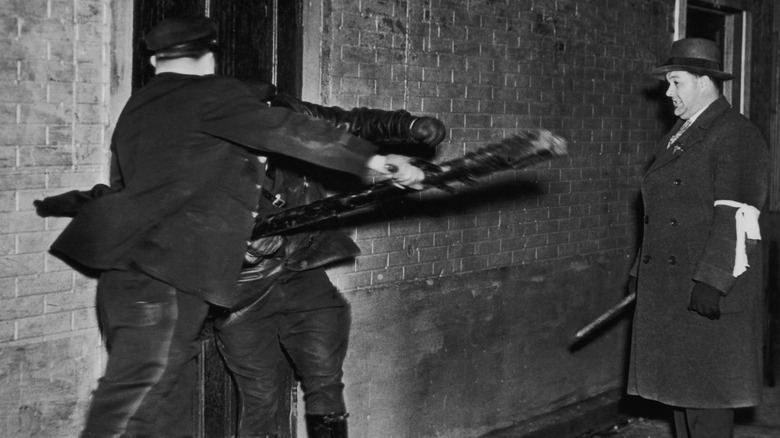The Shocking Riot In Hershey's History
Hershey's is perhaps one of the most recognizable chocolate brands in the world. Founded in 1894 by confectioner Milton S. Hershey, the candy company became successful enough to warrant the development of an entire town. According to Brittanica, Hershey founded the Pennsylvania-based Lancaster Caramel Company in the 1880s but decided to turn his attention to chocolate after witnessing the incredible German-engineered chocolate-processing equipment at the World's Columbian Exposition in Chicago in 1893. Just one year later, he founded The Hershey Company.
At first, Hershey focused on making sweet milk chocolate coatings for his caramel candies (via Companies History). But in 1900, he decided to sell the Lancaster Caramel Company to concentrate solely on manufacturing milk chocolate candies, per Brittanica. By 1903, Hershey's chocolate-making business had become so successful that he began construction on a brand-new chocolate-manufacturing facility in Derry Township, Pennsylvania. Soon, the area surrounding the factory was booming with employees, and as business continued to grow, the town of Hershey, Pennsylvania grew up with it.
Hershey employees received relatively good wages and benefits during the Great Depression
In 1906, Milton Hershey built a landscaped park, complete with a bandstand and pavilion, to give the residents of his namesake town a place to enjoy some leisure and recreation in their spare time (via Hershey). And, in the years that followed, he continued to add new additions to Hershey Park, including a merry-go-round, carousel, roller coasters, and even a water park in 2007.
However, the history of The Hershey Company wasn't all as idyllic as Hershey's tours might like you to believe. Like at any other major factory, there were workers, and there were bosses, and there was bound to be contention between the two, particularly in early 20th century America. Although Hershey's employees did receive relatively high wages, stability, and even pensions and health insurance during the Great Depression, when many other Americans struggled to find work, tensions between laborers and bosses were beginning to rise throughout the 1930s, according to History. Hershey was known to be a domineering boss, who made swift, cold decisions regarding the hiring and firing of his employees. So while they may have been making sweet chocolate, his behavior left a sour taste in many worker's mouths.
The United Chocolate Workers local was formed in 1937
By the late 1930s, the labor rights movement had gained steam, with workers mobilizing across the country to demand fairer wages and better working conditions from their employers. Workers at The Hershey Company were no different, particularly Italian immigrant workers, who were often relegated to lower-paying positions, according to Explore PA History. In 1937, the Congress of Industrial Organizations (CIO) approached Hershey workers about organizing, and managed to convince several hundred workers to join the United Chocolate Workers local.
The newly organized factory workers set to work demanding an increase in the minimum wage. At first, their organizing effort seemed to be successful, with management agreeing to raise wages. However, just a short time later, in what appeared to be an act of retaliation by management, The Hershey Company then laid off a group of so-called "seasonal workers," cut working hours, and took away bonuses (via History). In response, the workers decided to strike until they had their hours and bonuses restored.
Hershey workers modeled their strike after that of General Motors employees
Taking their inspiration from workers at General Motors, who had organized a successful 44-day long sit-down strike at their factories just a few weeks before, which ended with a wage increase and union recognition, Hershey factory workers decided the best plan of action was for them to embark on a sit-down strike too, per History.
On the morning of April 2, 1937, union president Russell Behma set the strike into motion by waving a red handkerchief in the front of the plant, alerting over 600 workers that it was time to stop working and sit down on the plant floor, according to Explore PA History. Although Hershey's lawyers and union representatives did set to work quickly, trying to hammer out a negotiation, they were far from reaching a settlement that would be satisfying to both parties. To further confuse matters, not every worker participated in the strike, so some employees continued to come into the factory to work while others occupied the floor with their sit-down strike.
Dairy farmers and other locals opposed the strike
Additionally, the strike was remarkably unpopular with many locals, particularly the dairy farmers of six nearby counties, who made their living selling milk to the Hershey chocolate factory. "What do you do if you are a dairy farmer and Hershey doesn't need your milk? There was intense local sentiment against (the strike)," Lebanon County Historical Society Archivist Adam Bentz explained to Lebanon Daily News. According to Explore PA History, local farmers were selling 60,000 to 70,000 gallons of milk per day to the factory ahead of the strike.
Some factory workers also remained loyal to Milton Hershey, going so far as to counter-organize against the strike. Other locals refused to back the strike because they were suspicious of the CIO in general, believing it to be a communist, anti-American organization (via Explore PA History). Anti-strike protesters and Hershey loyalists began to gather and march in retaliation, and tensions between the strikers and anti-strikers began to bitterly divide the town of Hershey, Pennsylvania.
The Hershey strike ended with a violent confrontation
On April 7, 1937, as reported by History, all hell broke loose as an angry group of 3,000 to 4,000 anti-strikers stormed the factory and attacked employees refusing to work (New York Times). They entered the building, armed with a slew of improvised weapons, including clubs and ice picks, and a violent confrontation between the strikers and the loyalists ensued. By the time the dust settled, 25 strikers had been injured in the riot, per Lebanon Daily News.
The violence brought an end to the strike and two years later, potentially due to the riot at The Hershey Company, the U.S. Supreme Court made sit-down strikes illegal, per History. However, after more fighting, this time within the court system, Hershey employees did ultimately unionize, and today, they are represented by a chapter of the Bakery, Confectionary, Tobacco Workers and Grain Millers' International Union (via Lebanon Daily News).

